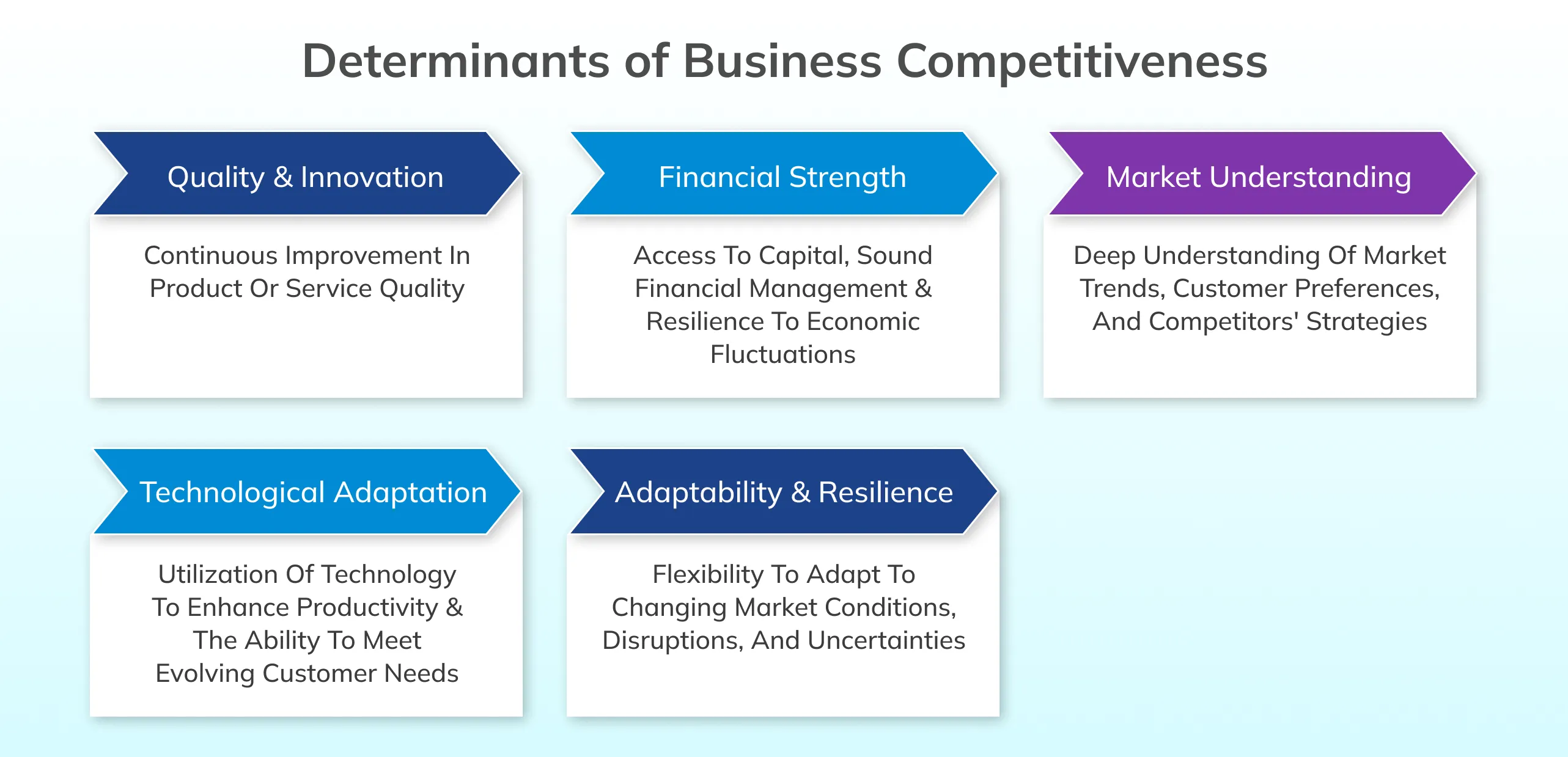
Every year, the penetration of newer players is fueling the competitiveness of the business environment. To outshine competitors, enterprises must act fast and out of the box. Businesses should identify their strengths and weaknesses and prioritize converting the latter into their advantages to outperform their rivals in the market. Ensuring this involves a holistic approach encompassing factors such as product quality, innovation, pricing strategies, customer service, and operational efficiency. A competitive business continuously assesses market trends, identifies strengths and weaknesses, and adapts strategies to seize growth opportunities.
However, a business's growth trajectory is never linear. Companies have to maneuver through several obstacles before reaching their goal of business competitiveness. Likewise, after reaching their goal, they must put in much effort to remain competitive. For instance, economic uncertainties and geopolitical factors are a constant and will create competitive hurdles. Factors like this and others lead to diminished productivity and competitiveness.
This blog aims to discuss how to continuously improve business competitiveness by proactively addressing challenges and thriving in an ever-evolving business landscape. It's a journey that requires constant engagement and commitment.
Here are the top ways to enhance the competitiveness of your business:
Market understanding is a comprehensive grasp of various aspects of a target market, including its demographics, preferences, behaviors, trends, and competitive landscape. This understanding is instrumental in enhancing businesses' competitiveness in several ways. Businesses build products or services that cater to these demands by deeply comprehending customer needs and preferences, effectively differentiating themselves from competitors.
Additionally, understanding market dynamics enables businesses to identify emerging trends or shifts in consumer behavior, allowing for timely adjustments to strategies and offerings. Furthermore, market understanding provides insights into competitors' strengths and weaknesses, enabling businesses to refine their own strategies and positioning to gain an edge.
Brand differentiation involves establishing unique attributes or qualities that distinguish a company's products or services from those of competitors in the minds of consumers. This differentiation is crucial for businesses seeking to improve competitiveness. By identifying and emphasizing distinctive features, benefits, or values, a brand can carve out a distinct identity and position itself more effectively in the market. Brand differentiation enables businesses to stand out amidst fierce competition, attracting the attention and loyalty of customers who resonate with their unique offerings.
Moreover, it creates a perception of value and relevance, enhancing customer preference and willingness to pay premium prices. Differentiation also fosters brand loyalty and advocacy, as customers develop strong emotional connections with brands that align with their preferences and values. Furthermore, brand differentiation is a significant entry barrier for competitors, making it more challenging for them to replicate or compete directly.

Building a culture of innovation within a business is necessary for staying ahead of the competition. This involves a strategic commitment to continuously developing fresh ideas, innovative processes, or business models to stay ahead of competitors and meet changing market needs. This dedication to innovation is instrumental in improving businesses' competitiveness in several ways. It enables businesses to differentiate themselves by providing unique and novel solutions that address customer needs more effectively than existing alternatives. By constantly pushing the boundaries of what's possible, innovative businesses can create a reputation for being forward-thinking and cutting-edge, attracting customers seeking innovative solutions.
Innovation drives efficiency and productivity improvements, enabling businesses to operate more effectively and cost-efficiently than competitors. Whether through process innovations that streamline operations or product innovations that enhance performance, these efficiencies contribute to competitive advantage.
Embracing technology is a transformative strategy that can significantly enhance businesses' competitiveness across various industries. By integrating technological advancements into their operations, businesses can streamline processes, boost efficiency, and deliver superior customer experiences. Automation technologies, for instance, enable tasks to be completed faster and with greater accuracy, freeing up valuable time and resources for strategic activities. Data analytics tools offer key insights into customer behaviors, market trends, and operational performance, empowering businesses to make accurate decisions and plan accordingly.
Technology facilitates collaboration and communication, both internally and with external stakeholders, creating an interconnected network for sharing ideas and fostering a culture of creativity within organizations.
Utilizing technology enables businesses to stay ahead of competitors by continuously evolving their offerings and staying attuned to market dynamics.

Adaptation to market changes is the proactive process of adjusting business strategies, operations, and offerings in response to changes in market dynamics, consumer behaviors, technological advancements, or competitive pressures. This adaptive approach is crucial for improving business competitiveness, allowing companies to stay relevant, agile, and responsive in rapidly evolving environments. By closely monitoring market trends, consumer preferences, and the competitive landscape, businesses can identify emerging opportunities and threats early on, enabling them to pivot quickly and capitalize on new trends or address potential risks.
Additionally, adaptation enhances customer satisfaction and loyalty by ensuring that businesses remain aligned with changing expectations and preferences. Businesses that embrace adaptation are better equipped to navigate challenges and disruptions, such as economic downturns or regulatory changes, maintaining resilience and sustainability in the long run. Ultimately, by embracing adaptation to market changes, businesses enhance their competitiveness, seize new opportunities, and position themselves for long-term success.
Outsourcing is a strategic business practice in which companies delegate certain functions, tasks, or processes to external service providers. This approach plays a key role in enhancing competitiveness by enabling businesses to focus on core activities, access specialized expertise, and optimize operational efficiency. It allows companies to redirect internal resources and attention towards core competencies and strategic initiatives. By delegating non-core functions such as IT support, customer service, or payroll processing, businesses can streamline operations, reduce administrative burdens, and allocate resources more effectively to activities that directly contribute to their competitive advantage.
Moreover, outsourcing offers immediate access to better skills and knowledge that may not be available in-house. External service providers often possess expertise and experience in specific areas, allowing businesses to leverage their capabilities without the need for extensive training or investment. This access to specialized talent enables companies to innovate more rapidly, develop new products or services, and maintain a necessary edge in their respective industries.
In today's globalized and highly competitive market, businesses must continuously innovate and change to stay ahead. This approach gives a company the necessary competitive edge to attract and retain customers. Increased competitiveness also fosters efficiency and productivity within the organization, driving down costs and maximizing profitability. It encourages investment in research and development, leading to the creation of fresh products or services and the exploration of untapped markets. However, market volatility, changing consumer preferences, and technological disruptions pose significant hurdles to improving business competitiveness. Likewise, factors like globalization intensify competition, increasing pressure to innovate and maintain relevance. Furthermore, talent acquisition and retention remain key concerns, especially with evolving skill requirements. This is where outsourcing steps in as a strategic solution for businesses.
Invensis offers a wide range of outsourcing services spanning IT, business process outsourcing (BPO), and digital transformation solutions to empower businesses to focus on their core competencies while streamlining non-core functions. We help businesses optimize their operations, minimize costs, and drive efficiency using our expertise and experience over the years. Invensis's global presence and diverse talent pool allow organizations to access specialized skills and resources, enhancing their agility and competitiveness in today's dynamic market landscape.
Reach out to us to unlock fresh avenues for growth and innovation and excel in today's fiercely competitive business landscape with our back office services.
Category

Business profits are essential for sustainability. Explore impactful strategies on how to improve business profitability to enhance financial strength.
May 16, 2024
|

Optimized shipping costs help businesses achieve greater efficiency and resource allocation. Know how to reduce shipping costs here.
May 16, 2024
|

Outsourcing allows businesses to focus on core functions and accelerate growth. Get a comprehensive explanation of outsourcing in this blog.
May 20, 2024
|
